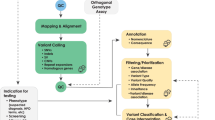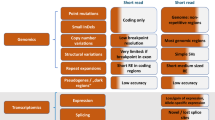Abstract
Around 5% of the population is affected by a rare genetic disease, yet most endure years of uncertainty before receiving a genetic test. A common feature of genetic diseases is the presence of multiple rare phenotypes that often span organ systems. Here, we use diagnostic billing information from longitudinal clinical data in the electronic health records (EHRs) of 2,286 patients who received a chromosomal microarray test, and 9,144 matched controls, to build a model to predict who should receive a genetic test. The model achieved high prediction accuracies in a held-out test sample (area under the receiver operating characteristic curve (AUROC), 0.97; area under the precision–recall curve (AUPRC), 0.92), in an independent hospital system (AUROC, 0.95; AUPRC, 0.62), and in an independent set of 172,265 patients in which cases were broadly defined as having an interaction with a genetics provider (AUROC, 0.9; AUPRC, 0.63). Patients carrying a putative pathogenic copy number variant were also accurately identified by the model. Compared with current approaches for genetic test determination, our model could identify more patients for testing while also increasing the proportion of those tested who have a genetic disease. We demonstrate that phenotypic patterns representative of a wide range of genetic diseases can be captured from EHRs to systematize decision-making for genetic testing, with the potential to speed up diagnosis, improve care and reduce costs.
This is a preview of subscription content, access via your institution
Access options
Access Nature and 54 other Nature Portfolio journals
Get Nature+, our best-value online-access subscription
$29.99 / 30 days
cancel any time
Subscribe to this journal
Receive 12 print issues and online access
$209.00 per year
only $17.42 per issue
Buy this article
- Purchase on Springer Link
- Instant access to full article PDF
Prices may be subject to local taxes which are calculated during checkout





Similar content being viewed by others
Data availability
Summary level data on frequency and importance of phecodes in the model are presented in Supplementary Table 3. Summary data on clinical and genetic information are provided throughout the paper. All requests for raw (for example CNV and phenotype) data and materials are reviewed by Vanderbilt University Medical Center to determine whether the request is subject to any intellectual property or confidentiality obligations. For example, patient-related data not included in the paper may be subject to patient confidentiality. Any such data and materials that can be shared will be released via a material transfer agreement. ClinGen data were downloaded from UCSC Genome Browser June 2019 (https://genome.ucsc.edu/cgi-bin/hgGateway). DECIPHER CNV syndromes were extracted from https://www.deciphergenomics.org/disorders/syndromes/list.
Code availability
All code used to construct and run the model is provided at https://github.com/RuderferLab/chromosomalMicroarray.
References
Nguengang Wakap, S. et al. Estimating cumulative point prevalence of rare diseases: analysis of the Orphanet database. Eur. J. Hum. Genet. 28, 165–173 (2020).
Ferreira, C. R. The burden of rare diseases. Am. J. Med. Genet. A 179, 885–892 (2019).
Rosenthal, E. T., Biesecker, L. G. & Biesecker, B. B. Parental attitudes toward a diagnosis in children with unidentified multiple congenital anomaly syndromes. Am. J. Med. Genet. 103, 106–114 (2001).
About Rare Diseases (Orphanet, accessed June 2020); https://www.orpha.net/consor/cgi-bin/Education_AboutRareDiseases.php?lng=EN
About Rare Diseases (EURORDIS Rare Diseases Europe, accessed June 2020); https://www.eurordis.org/about-rare-diseases
Suther, S. & Kiros, G.-E. Barriers to the use of genetic testing: a study of racial and ethnic disparities. Genet. Med. 11, 655–662 (2009).
Noll, A. et al. Barriers to Lynch syndrome testing and preoperative result availability in early-onset colorectal cancer: a national physician survey study. Clin. Transl. Gastroenterol. 9, 185 (2018).
Moreno-de-Luca, D. et al. Clinical genetic testing in autism spectrum disorder in a large community-based population sample. JAMA Psychiatry 77, 979–981 (2020).
OMIM: Online Mendelian Inheritance in Man (Johns Hopkins University, accessed June 2020); https://omim.org
McKusick, V. A. Mendelian Inheritance in Man and its online version, OMIM. Am. J. Hum. Genet. 80, 588–604 (2007).
Cooper, D. N., Krawczak, M., Polychronakos, C., Tyler-Smith, C. & Kehrer-Sawatzki, H. Where genotype is not predictive of phenotype: towards an understanding of the molecular basis of reduced penetrance in human inherited disease. Hum. Genet. 132, 1077–1130 (2013).
Girirajan, S. et al. Phenotypic heterogeneity of genomic disorders and rare copy-number variants. N. Engl. J. Med. 367, 1321–1331 (2012).
Posey, J. E. et al. Resolution of disease phenotypes resulting from multilocus genomic variation. N. Engl. J. Med. 376, 21–31 (2017).
Goldstein, B. A., Navar, A. M., Pencina, M. J. & Ioannidis, J. P. A. Opportunities and challenges in developing risk prediction models with electronic health records data: a systematic review. J. Am. Med. Inform. Assoc. 24, 198–208 (2017).
Bastarache, L. et al. Improving the phenotype risk score as a scalable approach to identifying patients with Mendelian disease. J. Am. Med. Inform. Assoc. 26, 1437–1447 (2019).
Bastarache, L. et al. Phenotype risk scores identify patients with unrecognized Mendelian disease patterns. Science 359, 1233–1239 (2018).
Denny, J. C. et al. Systematic comparison of phenome-wide association study of electronic medical record data and genome-wide association study data. Nat. Biotechnol. 31, 1102–1111 (2013).
Firth, H. V. et al. DECIPHER: Database of Chromosomal Imbalance and Phenotype in Humans Using Ensembl Resources. Am. J. Hum. Genet. 84, 524–533 (2009).
Corbett-Davies, S. & Goel, S. The measure and mismeasure of fairness: a critical review of fair machine learning. Preprint at arXiv https://arxiv.org/abs/1808.00023 (2018).
Lundberg, S. M. et al. From local explanations to global understanding with explainable AI for trees. Nat. Mach. Intell. 2, 56–67 (2020).
McInnes, L., Healy, J. & Melville, J. UMAP: uniform manifold approximation and projection for Dimension reduction. Preprint at arXiv https://arxiv.org/abs/1802.03426 (2018).
Brokamp, C. et al. Material community deprivation and hospital utilization during the first year of life: an urban population-based cohort study. Ann. Epidemiol. 30, 37–43 (2019).
Breiman, L. Random forests. Mach. Learn. 45, 5–32 (2001).
Wang, K. et al. PennCNV: an integrated hidden Markov model designed for high-resolution copy number variation detection in whole-genome SNP genotyping data. Genome Res. 17, 1665–1674 (2007).
Diskin, S. J. et al. Adjustment of genomic waves in signal intensities from whole-genome SNP genotyping platforms. Nucleic Acids Res. 36, e126 (2008).
Amemiya, H. M., Kundaje, A. & Boyle, A. P. The ENCODE blacklist: identification of problematic regions of the genome. Sci. Rep. 9, 9354 (2019).
Acknowledgements
This work was supported by R01MH111776 (to D.M.R.), R01MH113362 (to N.J.C. and D.M.R.), R01LM010685 (to L.B.) and U01HG009068 (to N.J.C.). This study makes use of data generated by the DECIPHER community. A full list of centers that contributed to the generation of the data is available from https://decipher.sanger.ac.uk and via email from decipher@sanger.ac.uk. Funding for the project was provided by Wellcome. The dataset(s) used for the analyses described were obtained from Vanderbilt University Medical Center’s BioVU, which is supported by institutional funding, private agencies and federal grants. These include the NIH-funded Shared Instrumentation Grant S10RR025141, and CTSA grants UL1TR002243, UL1TR000445 and UL1RR024975. Genomic data are also supported by investigator-led projects that include U01HG004798, R01NS032830, RC2GM092618, P50GM115305, U01HG006378, U19HL065962 and R01HD074711; and additional funding sources listed at https://victr.vanderbilt.edu/pub/biovu/.
Author information
Authors and Affiliations
Contributions
D.M.R. and T.J.M. designed and conceived the study. L.B. and T.J.M. extracted data from the EHRs for training and validation. L.H. generated the CNV data. T.J.M., D.M.R. and J.M. designed and implemented the prediction model. T.J.M. and D.M.R. performed the analyses. V.M.C. and R.H.P. performed external validation at MGB. D.M.R., T.J.M., L.B. and N.J.C. interpreted the results. T.J.M. and D.M.R. drafted the paper. All authors read the paper, provided feedback and approved the submission.
Corresponding author
Ethics declarations
Competing interests
The authors declare no competing interests.
Additional information
Peer reviewer information Nature Medicine thanks Marc Williams and the other, anonymous, reviewer(s) for their contribution to the peer review of this work. Michael Basson was the primary editor on this article and managed its editorial process and peer review in collaboration with the rest of the editorial team.
Publisher’s note Springer Nature remains neutral with regard to jurisdictional claims in published maps and institutional affiliations.
Extended data
Extended Data Fig. 1 PheWAS of CMA cases versus matched controls.
PheWAS Manhattan plot showing significance of associations from logistic regressions of each of 1,620 phecodes and whether an individual received a CMA vs controls. Triangle points represent direction of effect and points are colored by phecode category. For clarity, only phecodes with uncorrected p-values below 5 × 10−150 are labeled.
Extended Data Fig. 2 Age of patients at date of CMA testing differs by syndrome.
Age of patients at the time of their CMA report grouped into the most common syndromic region by combining diagnosis and genomic coordinates of reported abnormal variant. Independent patient numbers within each category: 15q11.2 syndromes (32), 16p11.2 syndromes (14), 1q21.1 syndromes (9), CMT/HNPP (18), DiGeorge/22q11.2 Duplication syndrome (31), Down Syndrome (7), Turner/Klinefelter (14), Williams syndrome (9).
Supplementary information
Rights and permissions
About this article
Cite this article
Morley, T.J., Han, L., Castro, V.M. et al. Phenotypic signatures in clinical data enable systematic identification of patients for genetic testing. Nat Med 27, 1097–1104 (2021). https://doi.org/10.1038/s41591-021-01356-z
Received:
Accepted:
Published:
Issue Date:
DOI: https://doi.org/10.1038/s41591-021-01356-z
This article is cited by
-
Performance and clinical utility of a new supervised machine-learning pipeline in detecting rare ciliopathy patients based on deep phenotyping from electronic health records and semantic similarity
Orphanet Journal of Rare Diseases (2024)
-
Cluster analysis and visualisation of electronic health records data to identify undiagnosed patients with rare genetic diseases
Scientific Reports (2024)
-
A machine learning model identifies patients in need of autoimmune disease testing using electronic health records
Nature Communications (2023)
-
Ontologizing health systems data at scale: making translational discovery a reality
npj Digital Medicine (2023)
-
Leveraging genomic diversity for discovery in an electronic health record linked biobank: the UCLA ATLAS Community Health Initiative
Genome Medicine (2022)



